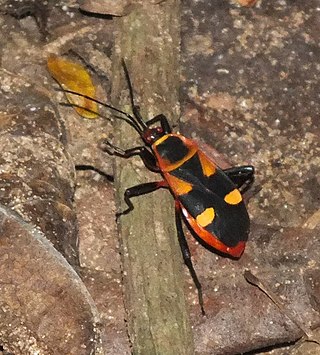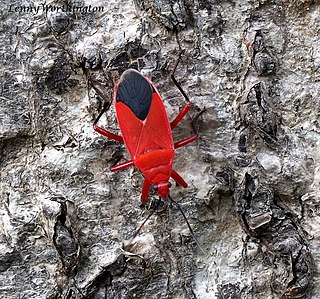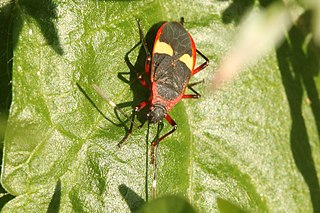
In Greek mythology, Antilochus was a prince of Pylos and one of the Achaeans in the Trojan War.

Pyrrhocoridae is a family of insects with more than 300 species world-wide. Many are red coloured and are known as red bugs and some species are called cotton stainers because their feeding activities leave an indelible yellow-brownish stain on cotton crops. A common species in parts of Europe is the firebug, and its genus name Pyrrhocoris and the family name are derived from the Greek roots for fire "pyrrho-" and bug "coris". Members of this family are often confused with, but can be quickly separated from, Lygaeidae by the lack of ocelli on the top of the head.

Nepomorpha is an infraorder of insects in the "true bug" order (Hemiptera). They belong to the "typical" bugs of the suborder Heteroptera. Due to their aquatic habits, these animals are known as true water bugs. They occur all over the world outside the polar regions, with about 2,000 species altogether. The Nepomorpha can be distinguished from related Heteroptera by their missing or vestigial ocelli. Also, as referred to by the obsolete name Cryptocerata, their antennae are reduced, with weak muscles, and usually carried tucked against the head.

The Lygaeidae are a family in the Hemiptera, with more than 110 genera in four subfamilies. The family is commonly referred to as seed bugs, and less commonly, milkweed bugs, or ground bugs. Many species feed on seeds, some on sap or seed pods, others are omnivores and a few, such as the wekiu bug, are insectivores. Insects in this family are distributed across the world.

A woodlouse is any crustacean belonging to the suborder Oniscidea within the order Isopoda. They get their name from often being found in old wood, and from louse, a parasitic insect, although woodlice are neither parasitic nor insects.

Corizus hyoscyami is a species of scentless plant bug belonging to the family Rhopalidae, subfamily Rhopalinae. It is commonly called the cinnamon bug or black and red squash bug.

The western red bat or desert red bat is a species of microbat in the family Vespertilionidae. It is found in western North America and Central America.

Roscius is an Afrotropical genus of true bugs in the family Pyrrhocoridae, the cotton stainers. They are often confused with bugs in the family Lygaeidae, such as the genus Oncopeltus, but can be distinguished by the lack of ocelli on the head.

Dysdercus is a widespread genus of true bugs in the family Pyrrhocoridae; a number of species attacking cotton bolls may be called "cotton stainers".

Antilochus is an Old World genus of true bugs in the family Pyrrhocoridae, erected by Carl Stål in 1863. Species in this genus occurs in tropical Africa including Madagascar, South and Southeast Asia, the Malay Archipelago, and New Guinea.

Dysdercus cingulatus is a species of true bug in the family Pyrrhocoridae, commonly known as the red cotton stainer. It is a serious pest of cotton crops, the adults and older nymphs feeding on the emerging bolls and the cotton seeds as they mature, transmitting cotton-staining fungi as they do so.

Dysdercus suturellus is a species of true bug in the family Pyrrhocoridae, commonly known as a cotton stainer. The adult insect is slender, about 1 to 1.5 cm long, with a red thorax and dark brown wings marked with a yellow cross. It is native to the southeast of the United States, Jamaica and Puerto Rico. It is a pest of cotton crops and other plants, the adults and older nymphs feeding on the emerging bolls and the ripening seeds.

Dysdercus koenigii is a species of true bug in the family Pyrrhocoridae, commonly known as the red cotton stainer. It is a serious pest of cotton crops, the adults and older nymphs feeding on the emerging bolls and the cotton seeds as they mature, transmitting cotton staining fungi as they do so.
Antilochus was the son of Nestor, king of Pylos, in Greek mythology.

Dysdercus andreae, or St. Andrew's cotton stainer, is a species of red bug in the family Pyrrhocoridae. It is found on islands in the Caribbean Sea and in North America. Its host plant is Thespesia populnea, which it feeds on the seeds and fruits of.

Dysdercus concinnus, known generally as the pale red bug or Turk's cap red bug, is a species of red bug in the family Pyrrhocoridae. It is found in Central America, North America, and South America.
Dysdercus bimaculatus, the two-spotted cotton stainer, is a species of red bug in the family Pyrrhocoridae. It is found in North America, and South America.

Dysdercus mimulus is a species of red bug in the family Pyrrhocoridae. It is found in the Caribbean, Central America, and North America.

P. Judson is an Indian Entomologist, who researched much on Dysdercus cingulatus in the 1970s. In the successive decades, he took to teaching of Zoology at Osmania University, Secunderabad, a State-run University u/s 2 (f) of the University Grants Commission Act, 1956. He contributed much to the discipline of Entomology through scholarly articles in scientific journals (see section on writings). He was also a member of the Indian Society for Comparative Animal Physiology.

Dysdercus albofasciatus is a species of true bug in the family Pyrrhocoridae. It is found in Argentina, Brazil, Paraguay, and Uruguay.

















